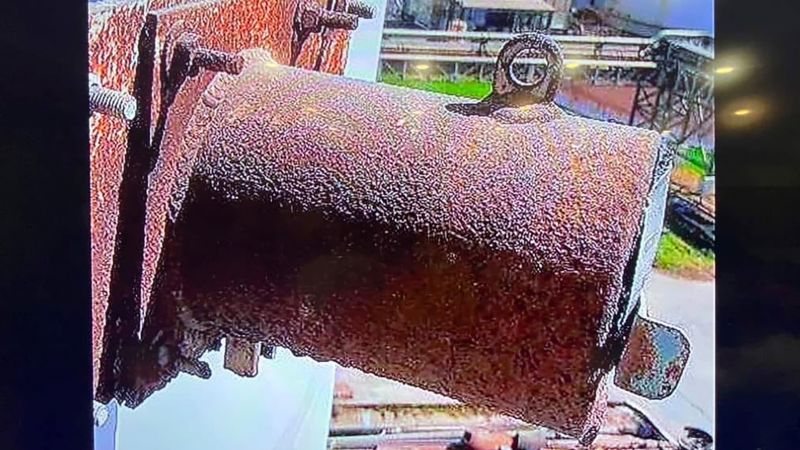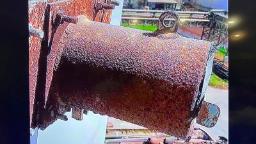

Bangkok, Thailand
CNN
—
Authorities in Thailand are scrambling to locate a metal cylinder with dangerous radioactive contents that went missing from a power plant this week, warning the public of serious health risks should they come across it.
The revelation comes just two months after Australia was forced to launch a similar hunt to find a tiny radioactive capsule that was eventually located by the side of a highway.
But while that Australian capsule was lost in the country’s remote outback hundreds of miles from the nearest major city – the Thai canister has disappeared in a much more populated area.
The cylinder, measuring 30 centimeters (4 inches) long and 13 centimeters (5 inches) wide, was reported missing during routine checks by staff on March 10, at the coal power plant in Prachin Buri, a province in central Thailand, east of the capital Bangkok.
The province has a population of nearly half a million people and houses some of Thailand’s best national parks, including the famed Khao Yai National Park which is popular with both local and international tourists.
The parks are a common day trip from nearby Bangkok, a sprawling megacity of some 14 million people.
Used for measuring ash, the cylinder was part of a silo and contains Caesium-137, a highly radioactive substance that scientists say is potentially lethal.
Search teams and drones have been deployed to recover the missing cylinder, according to a statement from the Office of Atoms for Peace (OAP), a government regulator for radioactive and nuclear research in Thailand.
Deputy Secretary General Pennapa Kanchana told CNN on Wednesday they were using radioactive detection equipment to locate the cylinder.
“We are searching in waste recycling shops in the area,” she said. “We are (using) survey equipment to detect for signals. For areas we cannot reach, we have dispatched drones and robots.”
Also involved in the search are Thai police, who believe the cylinder has been missing since February but was only officially reported lost by the National Power Plant 5 company on Friday.
Police have examined CCTV footage from the plant, Si Maha Phot district police chief Mongkol Thopao told CNN – but were hindered by “limited views” of the machine.
“It is unclear if the item was stolen and sold to a recycling shop or misplaced elsewhere,” Mongkol said. “We have dispatched our teams to recycle shops around the area… we still couldn’t find it.”
Experts warn that Caesium-137 can create serious health problems for people who come into contact with it: skin burns from close exposure, radiation sickness and potentially deadly cancer risks, especially for those exposed unknowingly for long periods of time.
Caesium-137 has a half-life of about 30 years, which means it could pose a risk to the population for decades to come, if not found.
Pennapa, from the Office of Atoms for Peace, urged the public not to panic.
“If general people (come into) contact unknowingly, the health effects will depend on the level of the (radiation) intensity. If it’s high, the first thing we will see is skin irritation.”
It is not the first time something like this has happened in Thailand.
In 2000, according to the Congressional Research Service report, canisters containing another radioactive isotope, cobalt-60, were bought by two scrap collectors, who took it to a junkyard where it was cut open.
Some workers suffered burn-like injuries, and eventually three people died and seven others suffered radiation injuries, the report said. Nearly 2,000 others who lived nearby were exposed to radiation.
But Pennapa said the canister that is currently missing is far less radioactive than the incident in 2000.
The most recent case in Thailand follows a similar incident in Western Australia in January when a tiny capsule, also containing Caesium-137, went missing along a remote outback highway while being transported from an iron ore mine to a depot in Perth.
After a challenging six-day search, the capsule was eventually found and officials are still investigating how it apparently fell off the back of a vehicle during transit.
Nuclear radiation experts in Australia who previously spoke to CNN said that the loss of that capsule was “very unusual” and spoke about challenges of recovering such a tiny device.
But a good thing, they said, was that the search area was extremely isolated.
“So it would be very unlikely to have much impact (on people),” said Ivan Kempson, an associate professor in Biophysics from the University of Southern Australia.
But there had been some past examples, Kempson noted, of people finding similar things and suffering radiation poisoning.
“The concern… is the potential impact on health of the person who would find the capsule,” he said.
